 The Comdex Report 2001: Part Two
The Comdex Report 2001: Part Two
By
Michael R. Tomkins, The Imaging Resource
(Tuesday, November 27, 2001 - 14:20 EST)
Asian manufacturers aplenty show some unusual imaging products...
As promised, our coverage of Comdex Fall 2001 continues in Part Two of our Comdex report, albeit somewhat later than planned thanks to a million and one computer problems that Mike's suffered through over the last week! If you've not already read part one of the report, hop on over and start there; if you're already up to date then read on...
Even though Comdex this year was much smaller than we've become accustomed to, there was a fairly significant number of Asian camera manufacturers represented, mostly specialising in the entry-level and toy camera section of the market. It can be difficult to keep track of which models are new amongst an array of companies we seldom hear from, and obviously the booth staff can be hesitant to admit that what's on show isn't brand-new... That said, we've tried to differentiate between the new and existing models where possible. Our apologies for the poor quality of some of the pictures; many companies seem to like putting their products under plexiglass 'domes' which make it almost impossible to get a good photo!
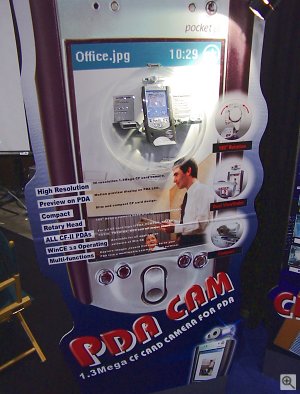 | Opcom's PDA CAM.
|
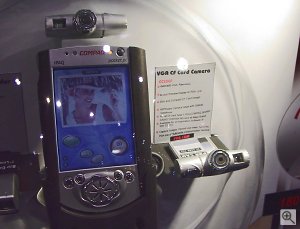 | Both PDA CAMs along with a Compaq PocketPC.
|
The first Asian company we came across at the back of the main show hall was Taipei, Taiwan-based Opcom Inc. (the name stands for 'OPtoelectronics and COMmunication'). The company was showing a woodblock prototype of its CC130CF PDA CAM, a 1.3 megapixel camera addon for Windows CE 3.0-based Palm-sized PCs. Fitting into a Type-II CompactFlash slot, the PDA CAM has a small 180-degree swivelling head on which the fixed focal-length lens and an optical viewfinder are mounted. Alongside this (but not on the swivelling portion of the head) is a shutter button, and as an alternative to the hardware viewfinder and shutter buttons, the image can be framed and the shutter triggered via software running on the PDA. As well as still images at a resolution of 1280 x 1024 pixels, the PDA CAM can also record video at an unspecified resolution. A lower-spec version, the CC33CF has similar features but with a maximum still-image resolution of 640 x 480 pixels (VGA).
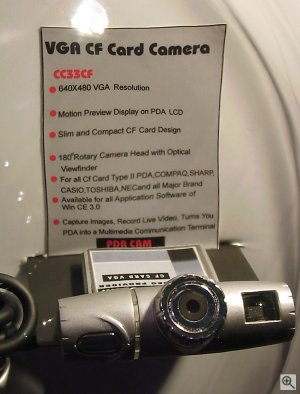 | Closeup of the megapixel PDA CAM.
|
 | Megapixel PDA CAM in the Compaq Pocket PC.
|
Opcom also had a range of existing products at the show, including the Digi Eye, Digi Clip and NB PC camera, all of which are low-resolution tethered web-cameras that clip onto the surround of a laptop computer's LCD display panel. There were also three of the now-ubiquitous 'pen cameras' which first started appearing a year or two ago, Opcom's line being called the Digi Pen I, II and III. THe company does have a couple of unusual features on its pen cameras that bear mentioning, though - not only do they feature 30fps tethered video for videoconferencing, plus the ability to store still images and brief video clips when not connected to a PC, but they can also function as motion-detecting cameras, capturing two images each time they detect motion up to a total of 400 images stored. Equally unusual (and apparently subject of patents in four countries) is the fact that the cameras also have laser pointers built-in, allowing for determining exactly what your camera is aimed at, and adding to the overall 'gadget value' of the device.
A simple plastic optical viewfinder is built in, and swivels over the lens when not in use, whilst the 'head' of the camera can be flipped up 90 degrees to let the camera rest on a computer monitor for videoconferencing. Opcom's Digi Pen devices use a combination of 8MB flash memory and 8MB SDRAM for storage, which means that if the batteries run out you could potentially lose up to half your images. Another negative point is the relatively low 0.4 megapixel resolution of the cameras - claimed resolutions of 1.3 and 2 megapixels on the packaging and camera bodies refer to interpolated output. At least this interpolation is done when images are transferred to the PC, however, so as not to waste valuable storage space.
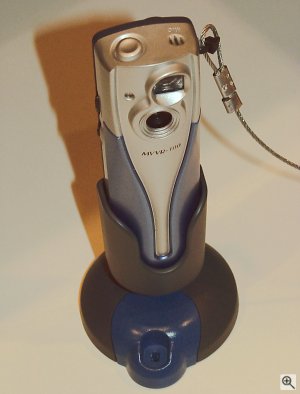 | Mustek's MVVR-100 pen camera.
|
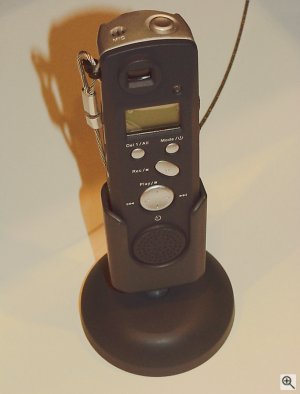 | MVVR-100 rear view.
|
Mustek, another Taiwanese manufacturer which has a line of scanners and digital cameras, had three digicam models which booth staff identified as new. One of these, the MVVR-100, was a pen camera model similar to those from Opcom, although the optical viewfinder is built-in, and the laser pointer is replaced with a microphone and speaker. The MVVR-100 functions as a still camera, video camera, tethered webcam, voice recorder and MP3 player. Unfortunately Mustek didn't have specifications on-hand, noting only that the camera had storage capacity for 200 images.
Overall, we'd see these pen cameras as fairly neat in that there are a range of features available in a very portable package, but we'd like to see low-power electronic viewfinders, improved storage and resolution and potentially even a small zoom lens added before these become the pen camera becomes a truly useful form-factor.
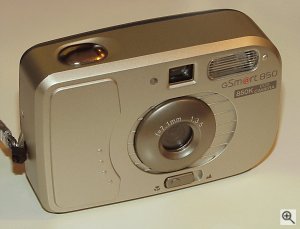 | gSmart 850 digital camera.
|
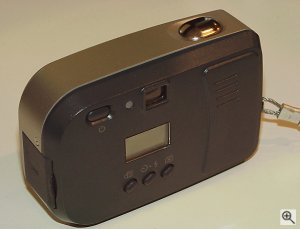 | gSmart 850 rear view.
|
Another new product from Mustek at the show was the gSmart 850 digital camera, a combo still / tethered webcam with a more conventional 'camera-like' form-factor. The gSmart 850 combines a Sony 850 Kpixel CCD sensor, 8MB of built-in flash memory, and an f/3.5 fixed focal-length, fixed focus lens with macro switch. There's no LCD for framing or image review, just an LCD info display, but the camera does have a built-in flash which can be set on, off or left to fire automatically as needed. The gSmart 850 has resolutions of 1024 x 768 or 640 x 480 pixels, or a 1280 x 960 pixel interpolated mode. Videos are either 640 x 480 pixels at 15 frames per second, or 320 x 200 pixels at 30 frames per second. Exposure and white balance are handled automatically, as you'd expect from a camera with no color LCD, and shutter speeds from 1/30 to 1/2500 second are offered. There's also a 10 second self-timer and USB connectivity. The gSmart 850 weight 126 grams without batteries, and has dimensions of 100 x 35 x 64mm.
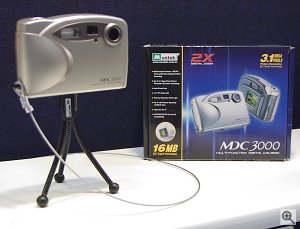 | MDC-3000 digital camera.
|
Finally Mustek's top-end digital camera, also new for the show, was the MDC 3000 - a 1.92 megapixel model using a Sony SuperHAD CCD sensor in combination with a fixed focal length, autofocus lens focusing from 20cm to infinity. The MDC 3000 also has a 1.8" 61,600 pixel LCD display for framing and image review, a choice of three apertures (f/2.8, f/5.6 or f/11) and shutter speeds from 1/25 to 1/2500 second. The camera has resolutions of 1600 x 1200 or 800 x 600 pixels, an interpolated 2048 x 1536 pixels, webcam video at 320 x 240 25 frames per second, and video clips of 320 x 240 pixels, 20 frames per second up to 30 seconds. The MDC 3000's built-in flash offers a red-eye reduction setting, and can be triggered automatically or manually, or disabled altogether. As with the previous camera, exposure and white balance are automatic, but the MDC 3000 does offer removeable CompactFlash storage, with a 16MB card bundled. There's also an optical viewfinder, 10 second self-timer, and video / USB connectivity. Power comes from 4 AA alkaline batteries, and the camera has dimensions of 116 x 42.5 x 75mm.
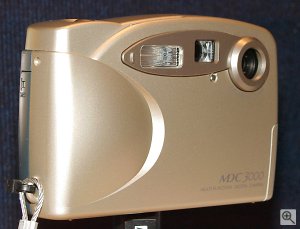 | MDC-3000 front view.
|
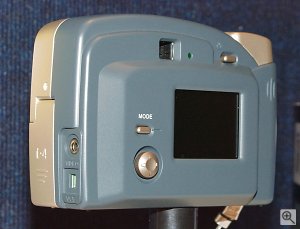 | MDC-3000 rear view.
|
As seems to be the trend with some manufacturers aiming cameras at the low end of the market, Mustek loudly proclaimed the interpolated resolutions of its cameras in the press kits and on the packaging we saw, hiding the real resolutions where the average buyer wouldn't see them. This is an approach we'd like to see come to an end, but that is unlikely to happen any time soon. Unfortunately, people buying these cameras are unlikely to understand the difference between interpolated resolutions and the optical resolutions listed by more reputable manufacturers, and may end up unhappy with their purchases as a result. The recent decision by the major manufacturers to quote real resolutions is a step in the right direction, but we'll be a lot happier when the Taiwanese manufacturers follow suit!
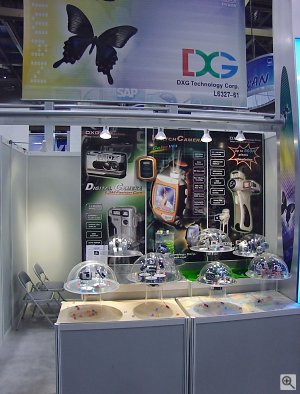 | DXG Technology Corp.'s booth.
|
Another Taiwanese digicam manufacturer present at Comdex was DXG Technology Corp., which had several quite unusual models on display. The first, and perhaps the furthest from any digicam form factor we've seen before, was the DSC-53 digital camera. Featuring a pistol-grip shape, the camera has a flash mounted on the top, and an optical viewfinder on one side. No specifications were available for this model, which looked like it could be quite well suited to fitting in an optical zoom lens. We couldn't imagine the design being very comfortable when using the optical viewfinder, but other than that drawback it looks quite interesting...
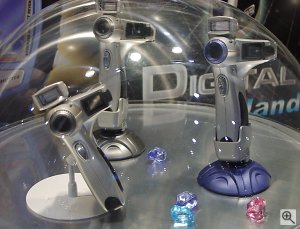 | Pistol-grip digicam.
|
Another design from DXG which was new at the show, and another for which no specs were available, was labelled the 'DXG Water Proof' (a name we presume is still subject to change). The display unit was a 1.3 megapixel camera featuring an f/2.8 - 3.5 fixed focal length lens with macro switch, mounted inside a glass tank full of water. There was no indication as to what depth the camera was waterproof to, nor any other specifications, but if the image quality turns out to be fair, this could be a good, cheap camera that outdoor types can take along where they wouldn't dare bring a more expensive (and fragile) camera.
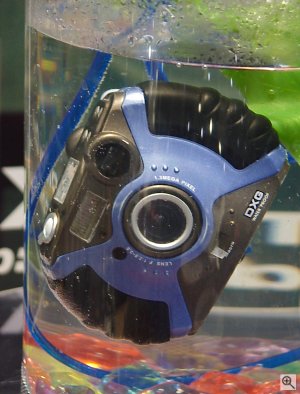 | Water-proof digicam.
|
A third camera (which we believe was displayed at PMA last February as well, although the specs have since been improved) was the Color Wrist Cam, a watch-style camera with a 350 Kpixel CMOS image sensor, 1.1" color LCD display and 8MB of flash memory for storing 100 VGA or 200 CIF images. The unit is powered by a rechargeable Lithium battery (charger bundled) rated at 600 shots battery life, whilst both USB and IrDA connectivity are provided for image transfer. The watch is water-resistant to 30 feet, and also features time, date, alarm and chronograph functions. Final specs should be available at the start of next year. A fairly impressive looking device if it meets its promise, this could give Casio's similar products a run for their money...
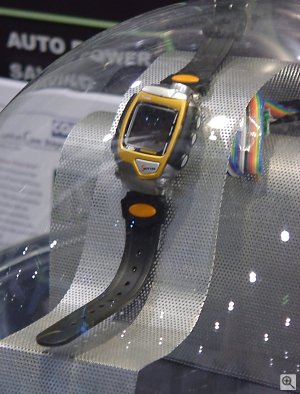 | Color Wrist Cam.
|
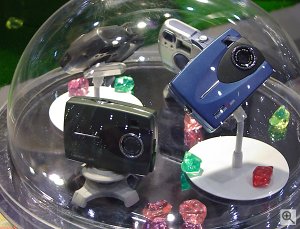 | DSC-03 Fashion Cam.
|
One last point of interest that we noticed on DXG's booth was the DSC-03 Fashion Cam, which we quickly realised was identical other than the logo to SiPix's StyleCam (announced last month) - the names are even almost the same. We don't know which company is the true manufacturer of the camera, but can't think of a reason why SiPix, who last January proclaimed their $100 million of funding and ability to manufacture a million digicams a month, would be rebadging them for an unheard-of third party company. That would suggest to us that perhaps the relationship is the exact opposite - perhaps SiPix has bought the design off DXG, or is even having the cameras manufactured for it by the lesser-known company? DXG apparently has a one million square-foot factory with 1600 employees in Shenzhen, which would be enough for a fairly significant output of cameras. SiPix meanwhile has facilities in Zhuhai and Shanghai...
Stay tuned for more in Part Three of our report, hopefully not to be delayed as much as Part Two was!
|